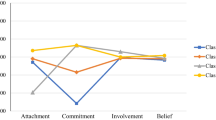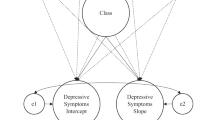Abstract
Data from the Youth in Transition study were used to examine issues in the measurement and causal analysis of the social bond as a factor in adolescent delinquency. Using the LISREL technique for simultaneous estimation of measurement and causal models, an eight-factor measurement model is derived. Examination of the independent effects of these eight factors on a measure of overall delinquency shows the importance of parental attachment, general school attachment, conventional beliefs, and involvement in youth subculture activities. An unexpected finding is the higher delinquency for those with higher mobility aspirations (controlling all other factors).
Similar content being viewed by others
References
Alexander, K. L., Eckland, B. K., and Griffin, J. (1975). The Wisconsin model of socioeconomic achievement: A replication.Am. J. Sociol. 81: 324–342.
Bachman, J. (1975).Youth in Transition Documentation Manual, Interuniversity Consortium for Political and Social Research, Ann Arbor, Mich.
Bandura, A. A. (1977).Social Learning Theory, Prentice-Hall, Englewood Cliffs, N.J.
Bentler, P. M., and Bonett, D. G. (1980). Significance tests and goodness of fit in the analysis of covariance structures.Psychol Bull. 88: 588–606.
Boocock, S. S. (1980).Sociology of Education: An Introduction, Houghton Miflin, Boston.
Cloward, R. A., and Ohlin, L. E. (1960).Delinquency and Opportunity, Free Press, New York.
Cohen, A. K. (1955).Delinquent Boys: The Culture of the Gang, Free Press, New York.
Cohen, J. A., and Cohen, P. (1975).Multiple Regression /Correlation Analysis for the Behavioral Sciences, Lawrence Erlbaum, Hillsdale, N.J.
Coleman, J. S. (1961).The Adolescent Society, Free Press, New York.
Damon, W. (1984). Self-understanding and moral development from childhood to adolescence. In Kurtines, W., and Gewirtz, J. (eds.),Morality, Moral Behavior and Moral Development, John Wiley, New York.
Diener, E., Fraser, S. C., Beaman, A. L., and Kerem, R. T. (1976). The effects of deindividuation variables on stealing among Halloween trick-or-treaters.J. Personal. Soc. Psychol. 33: 178–183.
Dull, T. (1984). An empirical examination of the social bond theory of drug use.Int. J. Addict. 19: 265–286.
Durkheim, E. (1951). In Spaulding, J. A., and Simpson, G. (ed. and Irans.),Suicide, Free Press, Glencoe, Ill.
Empey, L. T. (1978).American Delinquency, Dorsey Press, Homewood, Ill.
Gibbons, D. C. (1976).Delinquent Behavior, Prentice-Hall, Englewood Cliffs, N.J.
Gold, M., and Petronio, R. J. (1980). Delinquent behavior in adolescence. In Adleson, J. (ed.),Handbook of Adolescent Psychology, Wiley, New York.
Hindelang, M. (1973). Causes of delinquency: A partial replication and extension.Soc. Problems 20: 471–487.
Hirschi, T. (1969).Causes of Delinquency, University of California Press, Berkeley.
Janowitz, M. (1975). Sociological theory and social control.Am. J. Sociol. 81: 82–106.
Joreskog, K. B., and Sorbom, D. (1984).LISREL VI: Analysis of Linear Structural Relationships by the Method of Maximum Likelihood, Instrumental Variables, and Least Squares Methods, Scientific Software, Mooresville, Ind.
Kaplan, H., Martin, S., and Robbins, C. (1984). Pathways to adolescent drug use: Self-derogration, peer influence, weakening of social controls and early substance use.J. Health Soc. Behav. 25: 270–289.
Kohlberg, L. (1980).The Meaning and Measurement of Moral Development, Clark University Press, Worcester, Mass.
Krohn, M. D., and Massey, J. L. (1980). Social control and delinquent behavior: An examination of the elements of the social bond.Sociol. Q. 21: 529–543.
Long, J. S. (1976). Estimation and hypothesis testing in linear models containing measurement error.Sociol. Methods Res. 5: 157–206.
Matsueda, R. L. (1982). Testing control theory and differential association.Am. Sociol. Rev, 47: 489–504.
Merton, R. (1968).Social Theory and Social Structure, enlarged ed., Free Press, New York.
Nisbet, R. (1970).The Social Bond, Knopf, New York.
Perry, D. G., and Bussey, K. (1977). Self-reinforcement in high and low aggressive boys following acts of aggression.Child Dev. 48: 653–658.
Perry, D. G., and Bussey, K. (1984).Social Development, Prentice-Hall, Engiewood Cliffs, N.J.
Stinchcombe, A. L. (1964).Rebellion in High School, Quadrangle Books, Chicago.
Sutherland, E., and Cressey, D. R. (1978).Criminology, Lippincott, Philadelphia.
Thomson, A., Smith-DeJulio, K., and Matthews, T. (1982). Social control theory: Evaluating a model for the study of adolescent alcohol and drug use.Youth Soc. 13: 303–326.
Tinto, V. (1975). Dropout from higher education: A theoretical synthesis of recent research.Rev. Educ. Res. 45: 89–125.
Vincent, G. (1896). The province of sociology.Am. J. Sociol. 1: 473–491.
Wiatrowski, M. D., and Hansell, S. (1981). Competing conceptions of delinquent peer relations. In Jensen, G. F. (ed.),Sociology of Delinquency: Current Issues, Sage, Beverly Hills, Calif.
Wiatrowski, M. D., Griswold, D., and Roberts, M. K. (1981). Social control theory and delinquency.Am. Sociol. Rev. 46: 525–541.
Author information
Authors and Affiliations
Rights and permissions
About this article
Cite this article
Wiatrowski, M., Anderson, K.L. The dimensionality of the social bond. J Quant Criminol 3, 65–81 (1987). https://doi.org/10.1007/BF01065201
Issue Date:
DOI: https://doi.org/10.1007/BF01065201




